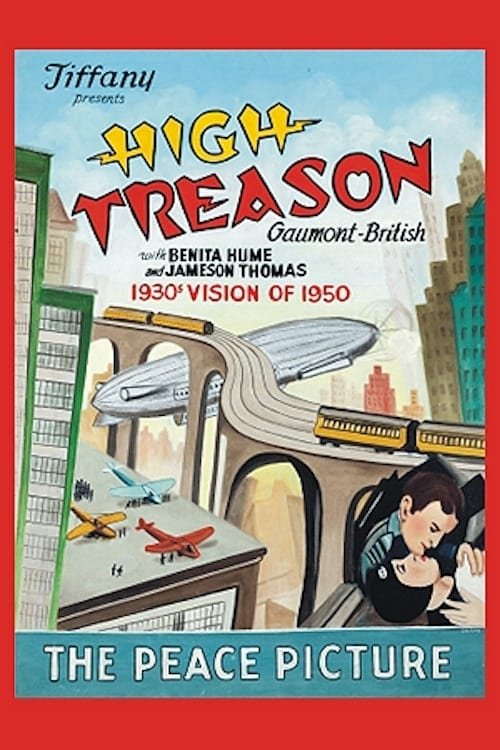Film Review: High Treason (1929)

Some of the most intriguing works in cinema history are not always the best. An example can be found in High Treason, 1929 British film also known as the first science fiction film with sound, and one of the greatest curiosities in the world of cinema.
The film's uniqueness stems from Noel Pemberton Billing, author whose colourful biography reads like fiction, including his involvement in aviation industry, populist right-wing politics, and a sensational libel trial during Great War. His 1928 stage play High Treason, written during his exile in Australia, was an attempt to maintain relevance. The plot of the film, directed by Maurice Elvey, is set in 1940, a time when two major blocs, the Atlantic States and Federated European States, teeter on the brink of war due to a border incident. The World League of Peace, influential mass organisation led by Dr. Seymour (played by Humberston Wright), tries to prevent conflict, while a love story between Seymour’s daughter Evelyn (played by Benita Hume) and Major Deene (played by Jameson Thomas) unfolds amidst political turmoil. As tension continues to escalate and President Deane (played by Basil Gil), Major’s father and President of Europe, opts for war he considers inevitable, both Evelyn and her father take desperate actions to prevent catastrophe.
Envisioned as a British response to Metropolis, the film's director, Maurice Elvey, known as one of the most prolific Britain’s film makers in first half of 20th Century, drew inspiration from Fritz Lang’s work. Equipped with relatively budget, he used miniatures and similar effects to create rather impressive Art Deco futuristic world in the landscapes of London and New York City. The most important influence on the film, however, was the emergence of sound cinema. Just like Blackmail, which had been produced roughly at the same time, High Treason was originally envisioned as silent film. Producers in both cases reacted to audience’s new found hunger for “talkies” by telling directors in the middle of production to make sound versions. High Treason was, just like Blackmail, simultaneously released as silent and sound film; the latter was, however, considered lost only to be discovered and partially restored only recently.
Like with most futuristic films from long time ago, today’s audience might find most fun by comparing its predictions about future with actual history. Despite some obvious misses, like in terms of fashion, music trends or Prohibition being still enforced in what goes for USA in film’s fictional world, High Treason holds surprisingly well in that regard. It successfully predicted world on brink of another global war in near future, its division in two major blocks instead of old Great Powers, women playing important role in politics and government, Channel Tunnel, gyrocopters, television and even video calls.
While solid for its time in strictly technical sense, High Treason falls short in quality compared to Blackmail. This is partly due to different levels of directing talent, and everyone would easily understand why Hitchcock is still legend, while Elvey is unknown outside hardcore cinephile circles. attributed to weak scriptwriting and lacklustre direction, highlighting the gap between Elvey and Hitchcock's genius. Another issues is terrible script by L’Estrange Fawcett which fails in world-building and character development, leaving too many plot holes and scene in which Atlantic States cabinet members imagine aerial bombing of New York City, while impressive, is only confusing to the audience. Another problem is romantic subplot that adds unnecessary melodrama and the rushed ending takes away a lot from film’s emotional impact. Some of today’s viewers, especially of feminist persuasion, might take offence on film’s mildly exploitative content, including relatively long scene in which Benita Hume’s characters takes a shower.
Another problem for High Treason is subpar acting, particularly by Jameson Thomas and Benita Hume, who apparently haven’t yet adapted to standards of sound cinema and whose performance looks stagey. Ironically, best performance belongs to Canadian actor Raymond Massey, who makes cinematic debut in small role of European cabinet member (and who would later play in similarly themed, but much better science fiction film Things to Come).
While definitely being product of its time, High Treason still has relevance today, mainly due to its strong and unapologetic anti-war stance. By late 1920s traumas of Great War have made even Billings change his hawkish views and adopt what most public in interwar period thought about next war – catastrophe that would bring nothing but misery except for profiteering arms manufacturers. In the film they are portrayed as true villains – an international cabal that allowed British audience first opportunity to hear screen characters speak “exotic” languages like French, German, Russian and Japanese.
Despite being a commercial failure, High Treason allowed Elvey to learn from it, leading to Transatlantic Tunnel, film with similar futuristic theme made only few years later, but noticeable technical improvements. High Treason stands as a captivating piece for enthusiasts of science fiction cinema history, offering a glimpse into early sound-era experimentation and thematic exploration of war and peace.
RATING: 5/10 (++)
Blog in Croatian https://draxblog.com
Blog in English https://draxreview.wordpress.com/
InLeo blog https://inleo.io/@drax.leo
Hiveonboard: https://hiveonboard.com?ref=drax
Rising Star game: https://www.risingstargame.com?referrer=drax
1Inch: https://1inch.exchange/#/r/0x83823d8CCB74F828148258BB4457642124b1328e
BTC donations: 1EWxiMiP6iiG9rger3NuUSd6HByaxQWafG
ETH donations: 0xB305F144323b99e6f8b1d66f5D7DE78B498C32A7
Posted using CineTV